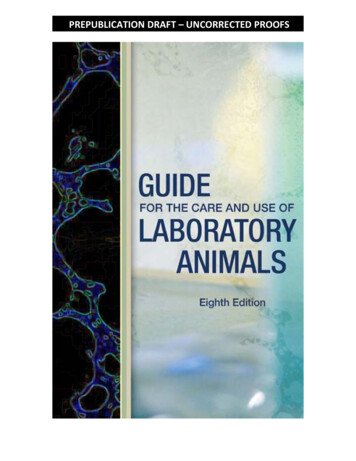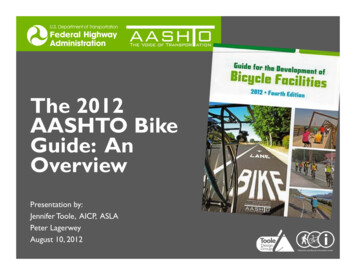
Transcription
The Guide to the USMBOK The Guide to the UniversalService Management Body ofKnowledgeA comprehensive guide to best practices for managing theprovision of servicesIan M. ClaytonService Management 101 Copyright 2008 Service Management 101 and VKSII
The Guide to the USMBOK An Element of the Service Management 101 SeriesThe Guide to the Universal Service Management Body of Knowledge (USMBOK )Version 2008.08cISBN: 978-0-9814691-0-2Copyright 2008 Virtual Knowledge Solutions International Incorporated. All worldwide rights reserved.Printed in the United States of AmericaPublished by Tahuti Enterprises LLCNo part of this publication shall be reproduced, stored in or introduced into a retrieval system, or transmitted in anyform or by any means (electronic, mechanical, photocopying, recording, or otherwise), except as permitted underSections 107 or 108 of the United States Copyright Act, and without either the prior written permission of the Publisher,or authorization through the appropriate per-copy fee as defined by a prevailing license. Requests for permission shouldbe directed to: info@vksii.dm.TRADEMARKS & COPYRIGHTS: Service Management 101 (SM101), the SM101 logo, USMBOK, USMBOK logo,Service Management Master, Lean Service Management, and Service Management Foundation, and related trade dressare trademarks or registered trademarks of Virtual Knowledge Solutions International Incorporated (VKSII) and maynot be used without written permission. All other trademarks are the property of their respective owners.LIMIT OF LIABILITY/DISCLAIMER OF WARRANTY: The publisher and author have used their best efforts inpreparing this book. The publisher and author make no representation or warranties with respect to the accuracy orcompleteness of the contents of this book and specifically disclaim any implied warranties of merchantability or fitnessfor a particular purpose. No warranty may be created or extended by sales representatives or written sales materials.The accuracy and completeness of the information provided herein and the opinions stated herein are not guaranteed orwarranted to produce any particular results and the advice and strategies contained herein may not be suitable for everyindividual. Neither the publisher nor author shall be liable for any loss of profit or any other commercial damages,including but not limited to special, incidental, consequential, or other damages. All representations or warranties thatmay be made in any advertising contained in this book are solely the responsibility of the offeror and neither publishernor author will have any liability in any regard based upon such representations or warranties.IDEAS & COMMENTS: Any ideas, suggestions, or comments regarding this publication and how it may be improvedmay be submitted at http://www.sm101-support.com.Copyright 2008 Service Management 101 and VKSII
The Guide to the USMBOK CONTENTSPREFACE TO THE THIS EDITION .IHOW THIS BOOK IS ORGANIZED.IIIIntroduction .iiiAudience for the Guide to the USMBOK . ivINTRODUCTION TO THE CONCEPT OF A ‘BODY OF KNOWLEDGE’.1WHAT IS A BODY OF KNOWLEDGE? .1THE UNIVERSAL SERVICE MANAGEMENT BODY OF KNOWLEDGE .2Deciphering the ‘Best Practice’ Concept.3Common Practice. 3Best Practice. 3Good Practice . 3The Practice Lifecycle. 4USMBOK Best Practice Statements (BPS). 4OVERVIEW OF THE SERVICE MANAGEMENT AREAS OF EXPERTISE .9UNIVERSAL SERVICE MANAGEMENT BODY OF KNOWLEDGE .10STANDARDS & REGULATIONS KNOWLEDGE AREA .11RELATED BODIES OF KNOWLEDGE AREA .11SERVICE ENVIRONMENT KNOWLEDGE AREA .12Cultural and Social Impact.12Organizational Impact.12Economic Impact .12Physical Environment .12GENERAL MANAGEMENT KNOWLEDGE AREA .13INTERPERSONAL SKILLS KNOWLEDGE AREA .13PROGRAM AND PROJECT MANAGEMENT CONTEXT .14Service Management Subprojects.14The Service Management Program Office (SMPO) .15INTRODUCTION TO SERVICE . 19WHAT IS A SERVICE? .19A Legal Definition.19The Goods-Service Continuum .21Product Generations - Good and Services Categories.22Information and Knowledge as a Service (INKAS). 22Copyright 2008 Service Management 101 and VKSII
The Guide to the USMBOK The Characteristics of a Service .23Service Intangibility. 23Service Inseparability . 24Service Perishability . 24Service Variability. 24Transaction-based Services .25Pre-Transaction . 26Transaction. 27Post-Transaction . 27The Service ‘Experience’, ‘Encounter’ and ‘Moment of Truth’.28The Nature of Service Encounters. 28The Context of Services. 30Best Practice Statements.30WHAT IS SERVICE MANAGEMENT?.32Product Management 101.32Key Product Management Concepts & Terms . 32The Product Lifecycle . 33Two Discrete Professions – Planning and Marketing. 35What is Service Alignment?.36Best Practice Statements.37THE ENTERPRISE MODEL .37Locations.37Organizations.37Roles .38Persons .38Regulations .38Best Practice Statements.38THE CUSTOMER MODEL .39Best Practice Statements.41THE SERVICE MODEL .42Types of Service Models.43The Global Service Model . 43Regional Service Model . 43Local Service Model. 43Designing and Managing a Service Model .44Best Practice Statements . 44VITAL SERVICE EQUATIONS .46The Value Equation.46The Expectation Equation .46The Quality Equation .47Best Practice Statements.49THE HIDDEN COST OF QUALITY – SUPPORT SERVICES .50THREE KEY CONSTITUENCIES .50THE INFLUENCE OF ‘ASYMMETRIC INFORMATION’.51THE INFLUENCE OF FORMAL CONTRACTS .52Copyright 2008 Service Management 101 and VKSII
The Guide to the USMBOK Service Contract .52Operations Contract.53Supplier Contract.53THE SPECIAL CASE OF ‘IT MISALIGNMENT’ .53THE IT ORGANIZATION’S RESPONSE – IT SERVICE MANAGEMENT .55GOLDEN RULES FOR SERVICE MANAGEMENT .56HOLISTIC SERVICE MANAGEMENT.57Spheres of Influence .58Elements of a successful HSM Strategy.60THE SERVICE MANAGEMENT SYSTEM .65INTRODUCTION TO THE SERVICE MANAGEMENT SYSTEM .65SERVICE MANAGEMENT SYSTEM ELEMENTS .66Best Practice Statements.69The Business Planning Framework.70The Corporate/Enterprise Planning Layer . 71Best Practice Statements . 73The Business Area Layer. 74The Implementation and Operation Layer . 75The Business Planning Cascade . 75Best Practice Statements . 76The Performance Management Framework .77Seven-Tier Measurement Model. 78Tier 1: Key Result Area (KRA) . 78Best Practice Statements . 78Tier 2: Key Performance Indicators (KPIs). 79Best Practice Statements . 79Tier 3: Key Performance Targets (KPTs) . 80Best Practice Statements . 80Tier 4: Vital Mission Activity (VMA). 82Best Practice Statements . 82Tier 5: Service Level Objective (SLO) . 83Best Practice Statements . 83Tier 6: Service Level Indicator (SLI) . 84Best Practice Statements . 84Tier 7: Service Infrastructure Events (SIE). 85Best Practice Statements . 85Best Practice Statements . 86Key Service Management System Artifacts.87The Service Governance Framework . 88The Service Planning Process. 88Capturing the Voice of the Customer. 88Best Practice Statements . 90The Service Fulfillment Plan . 91Common Elements of a Service Fulfillment Plan . 92The Service Plan . 93Best Practice Statements . 93The Service Portfolio. 94Copyright 2008 Service Management 101 and VKSII
The Guide to the USMBOK The Service Catalog . 96Service Catalog Schema. 97Making a Service Catalog ‘Actionable’. 98Best Practice Statements . 99The Service Calendar . 99Best Practice Statements . 100The Service Priority Scheme. 100Impact . 101Urgency. 101Priority Scheme Governance. 101Best Practice Statements . 102The Service Portal . 104Best Practice Statements . 104The Service Quality Lifecycle . 105ISO/IEC 9126. 105ISO/IEC 12207- Software Lifecycle .106Service Lifecycle Costs .108Lifecycle Concepts .109THE SERVICE LIFECYCLE.111Best Practice Statements.111Key Inputs to the Service Lifecycle.112Multiple Sources of an Improvement Statement . 113The Sources of Service Catalog based Service Requests. 113The Relationship between Incidents and Problems . 114Best Practice Statements.114How the Service Lifecycle Stages are discussed.115The Opportunity Stage.117Key Inputs. 117Major Activities. 118Customer Side Influences .119Provider Side Influences .120Key Outputs. 120Best Practice Statements .120Require.121Key Inputs. 121Major Activities. 122Customer Side Influences .124Provider Side Influences .124Key Outputs. 125Best Practice Statements .125Define.127Key Inputs. 128Major Activities. 128Customer Side Influences .130Provider Side Influences .
T H E E N D Index 4Ps of Marketing, 285 ADKAR Cycle, 402 Alignment Models, 36 Application Defined, 387 Application Development Environment, 389










